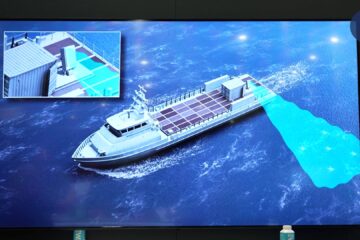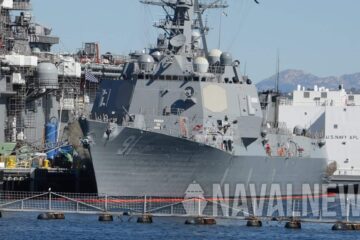NAVSEA press release
That platform is known as the total ship Frigate Readiness Assessment Model (FRAM). Members of Naval Surface Warfare Center (NSWC), Port Hueneme Division (PHD) are developing and testing FRAM with input from NSWC Corona in Norco, California and NSWC Carderock in Bethesda, Maryland.
FRAM implements a holistic modeling and simulation approach for acquisition and sustainment of ships’ systems and parts using the same toolset as the soon-to-launch Model Based Product Support (MBPS) platform. It also makes use of existing data sets and digital models of various combat systems that have already been identified to be used on the new frigate.
The FFG Program Office Readiness Working Group (PMS 515L) is overseeing the FRAM project under Program Executive Office, Unmanned and Small Combatants.
“The importance of FRAM is applying MBPS at a total ship level in acquisition, which will serve as foundation and baseline when the ship transitions to its lifecycle,” said Bob Howard, the acquisition supportability manager in NSWC PHD’s Littoral Strike and Warfare Department. Howard is leading the FRAM team at the command, which will serve as the in-service engineering agent (ISEA) for the new ship class.
“The FRAM enables influencing the program supportability early in a ship’s lifecycle to improve readiness and reduce cost by providing quantitative analysis, which can be used to understand trade space of decisions,” Howard added.
The FFG 62 is currently in detail design prior to construction by Fincantieri Marinette Marine in Marinette, Wisconsin. During this time, the FRAM team is able to help identify design flaws or other issues related to specific key readiness factors prior to the ship design’s final approval.
The readiness factors that the FRAM uses in its mission-based model are Personnel, Equipment, Supply, Training, Ordnance, Network and Infrastructure, referred to as PESTONI. The FRAM characterizes each category’s impacts to total ship readiness.
“We know there’s going to be a gun, a radar, engines, and so forth,” said Colin Hathaway, NSWC PHD’s performance and maintenance data analysis branch manager, who is overseeing the command’s FRAM team. “The goal of modeling all this before they build it is so we can influence the design.
“If there are components or systems that aren’t going to help meet the requirements for the ship, we can address those early before it’s actually fully built,” Hathaway added. “(Otherwise,) it’s hard to go back at that point; you have to redesign everything.”
For example, if the FRAM notes that a radar system intended for the ship requires a certain maintenance schedule, but the ship’s personnel profile indicates there will be too few qualified and trained Sailors to maintain the radar according to its requirements and set schedule, then the solution might be either to add more trained Sailors or build in an automated system test that identifies any potential problems in the maintenance cycle and sends alerts.
“It might be that a design change is the most efficient option, or it might be that we need to update the maintenance strategy that we have for this particular ship to make sure we address the problem so the system is not failing as often,” Hathaway said.
Not all combat systems have digital models associated with them, and that’s where the Advanced Model Build (AMB) teams come in. The MBPS and Legacy Logistics Information Technology systems program office (SEA03R) is leading the AMB initiative to rapidly develop digital readiness models for all Navy weapon systems using the MPBS Navy Common Readiness Model (NCRM) tool suite.
The AMB process is an interim model building process until MBPS is ready to launch later this fiscal year. The FRAM and AMB teams have been in regular contact since both were launched.
The AMB process draws data from legacy logistics information technology (IT) systems. SEA03R has committed to an aggressive readiness model build schedule, anticipating that all Navy weapon systems will be modeled by July 2021.
Warfare centers including NSWC PHD are working to build the models even as they correct data errors or inconsistencies in the authoritative data sources, collaborating with the weapon systems’ program offices, their subject matter experts and ISEAs.
Team members from PHD’s Air Dominance Department are working on models for the Aegis combat system, the MK41 vertical launch system, and hull, mechanical and electrical combat systems.
PHD’s FRAM team communicates with the AMB teams as new digital models of Navy combats systems are being built.
Hathaway noted that the FRAM and AMB teams have similar goals.
“That’s why we’ve been working together to try and figure out the correct model setup and the correct model application—so we have a consistent framework for how we are modeling,” he said.

The FRAM team has moved to the next phase beyond incorporating Navy-furnished equipment into the model, and members are now receiving systems information from the contractors designing the frigate. Information they get regularly could relate to electrical systems, water supply systems, engine design and other areas that require maintenance and possibly replacement parts for repair. As the model grows, the FRAM team continues to test and analyze results.
“We are looking at the different missions this particular ship will be assigned, and identifying the systems that ship’s force would need to have available and operational to accomplish those missions,” Hathaway said. “We are making sure we have a strategy in place, based on the design and our product support strategy, to meet the readiness requirements for these anticipated missions.”
If all the PESTONI do not line up with mission parameters, the FRAM can help identify and prioritize what things need to be adjusted within those seven factors and develop a corrective action with an anticipated timeline and potential cost.
“These modeling efforts will directly enable the ISEA to execute core functions such as sustainment engineering, maintenance engineering and other core integrated product support functions,” Howard said.
Hathaway pointed out that the outcome of FRAM will likely reach beyond just the FFG.
“Our goal is to develop a centralized, total ship decision support tool that can be used to help those decision makers in Washington, D.C., not just for this frigate program but for future programs as well,” he said.






